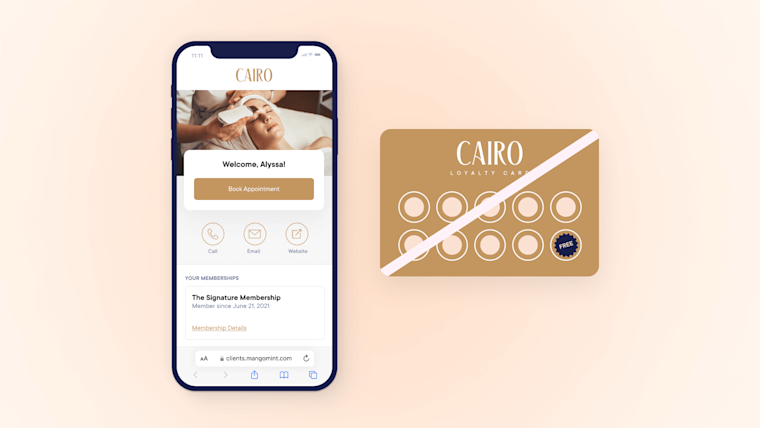
Salon and spa loyalty programs don’t work. Stop wasting your time.
Debunking myths about salon and spa loyalty programs and exploring why you won’t find them in Mangomint.

Founder / CEO
Over many years of running Mangomint, one thing that keeps coming up time and time again is the request for a loyalty program feature. I must have had hundreds, possibly even thousands of conversations with salon and spa owners who think that a loyalty program is what's missing in their business and who inquire why Mangomint still does not have such a feature to this day.
In this blog post, I'd love to share some of the perspectives and learnings that we have gathered over many years of talking to owners and managers, what we’ve learned from our research into loyalty programs, and why we ultimately decided not to build such a feature in Mangomint.
First up, what is a loyalty program anyway?
A lot of people have different ideas about what a loyalty program is. Generally speaking, when I talk to salon and spa owners about any type of loyalty or reward system, they refer to one of two different flavors:
1. Point-based systems
These are the most common ones. The basic idea is simple — clients earn points whenever they spend money with the business. The classic one is where people earn 1 point for every dollar spent.
I have come across some other more complicated structures as well, where the amount of points earned is dependent on the specific type of service that was received, whether or not retail products were purchased, or other behavior such as referring a friend or leaving a review on Google or Yelp.
Regardless of how the points are earned, there is typically a mechanism to redeem points at certain thresholds in exchange for some kind of reward. Rewards could be anything, but usually, they are a discount on the next visit, free products, or other benefits such as complimentary service add-ons.
2. Stamp loyalty cards
The other popular loyalty / reward system is to basically have some sort of “stamp card,” whether it’s digital or printed. Think “buy 10 tacos, get 1 free,” just in the world of beauty and wellness. So this could be massages, nail appointments, blow-dries, etc.
There’s really not much else to them usually, although sometimes people try to get creative and come up with different kinds of rewards after a certain number of stamps or sessions are collected. This is kind of rare, however, and I usually see the much more basic get-a-free-service reward.
I’m not saying there aren’t any other types of loyalty programs out there—I’m sure somebody will point out that theirs is much superior and is probably the best thing since the invention of sliced bread—but based on all the conversations that I’ve had, I’d say that 99% of the loyalty and rewards programs in salons and spas fall into one of these two categories.
The mechanism of how salon and spa loyalty programs are supposed to work
As the name already implies, loyalty programs are intended to encourage loyalty. Specifically, client loyalty in the form of repeat visits to a salon or spa.
Although the exact mechanism could be debated, it’s well understood that the idea is for clients to come back more often because they can anticipate some sort of future reward for their loyalty.
So, if we accept that the definition of success is that a client who would have otherwise not come back for a repeat visit will, in fact, come back as a result of the loyalty or reward program, let’s examine what would have to be true in order for this mechanism to work:
The client must know that there is a future reward coming, i.e. be aware of the loyalty program in the first place
The client must remember the loyalty program at the time when they decide to book another visit
The client must value the future reward enough so that they will actually change their behavior and choose to book with this particular business because of that future reward
The key thing here is that basic logic mandates that all three of these things have to be true, or else the client won’t actually change their behavior and the whole program is all for naught.
Digging into each component
Let’s take a closer look at each of these three components and why they are all flawed.
1. The client needs to know
The first problem is that a lot of times, clients have no idea about the loyalty program or simply don’t care.
If there is a receptionist, it might be their job to introduce new clients to the program and explain the benefits. But we all know that between the million different things that are going on at a busy front desk, a lot of staff will either forget about it or just won’t do it.
Of course, there is also the option to include something on a receipt—whether it’s digital or on paper. But how many people study these carefully, especially the section below the price where this information usually lives?
Last but not least, some software tools will send an automated follow-up email to let the client know that they just earned some points. Sounds great and easy, but now you’ve just added another email to an already busy inbox. How many people do you really think will open it and pay attention to the finer details of the math equation you just sent? Exactly.
2. The client must remember
Wouldn’t it be nice if we all had businesses where clients immediately rebook their next visit at the end of their service? While that sounds lovely, the reality is that the vast majority of repeat visits get booked many days, weeks, or even months after the previous visit.
Don’t believe me? We have the data to prove it, but if you’re one of the few who manages to get rebooked instantly, why do you need a loyalty program anyways?
So for the rest of us, where weeks and sometimes months pass between the client’s last visit and them booking another appointment, in order for the loyalty program to do anything to change their behavior, they really do have to remember it first.
I can barely recall what I had for lunch today. Definitely not the details of any spa loyalty program from several weeks ago. Maybe other people have better memory; who knows?
3. The client must value the reward enough
Lastly—and this is by far the most important reason loyalty programs are broken—clients must value the prospect of getting a future reward enough that they will, in fact, choose a particular business over another in anticipation of collecting that future reward.
Think about that for a second. If a client comes to your salon or spa and gets a treatment, what do you think is most likely to determine whether or not they will come back?
Is it quality of service, atmosphere, price, convenience, or experience? The answer is yes.
The idea that someone who would normally not come back to your particular business would somehow change their mind just because, at some future point in time, they get a reward is just ludicrous to me.
If delayed gratification worked so well, we would all be super healthy, eating our vegetables and putting 30% of our income every month into a 401k retirement account.
3 more reasons salon and spa loyalty programs suck
Now that we’ve established that loyalty programs don’t, in fact, create the intended behavior with your clients, let’s look at the other side of the coin and see what they will do to your business.
1. You’re giving away free money
Since we know that clients who wouldn’t have come back to your business will, in fact, not come back because of the program, who then is actually collecting the rewards? Answer: it’s the clients who would’ve been back anyways and would’ve happily spent the money.
So effectively you’ve given a discount to clients who didn’t need one or ask for one. I guess that can be okay if you’re already super profitable and don’t care about money. But for the rest of us, maybe not.
2. They introduce unnecessary complexity
Here at Mangomint, we’re all about keeping simple things simple. In fact, our mission statement is literally “to make salon and spa software invisible.”
Introducing a loyalty program is probably the worst thing you could do to your business if the goal is simplicity in your daily operations. As soon as you veer off just one inch from the simplest of programs (i.e. 1,000 points = $10 discount), you will have to deal with a lot of extra complexity.
There are endless questions: can points be redeemed for all services or only certain categories? Are some retail items excluded? What about gift cards—can you buy them with points? Why not? How about my mom who just moved out of state, can I transfer her points?
You get the idea. Staff will need to be constantly educated and re-educated on all these details, it will take extra time to explain those to clients, and last but not least, it will also add extra time during checkout to deal with point redemptions, duplicate accounts, etc.
3. They create anger and frustration
This is another reason that’s often overlooked. It turns out that when you have a loyalty or reward program, not only does it not change client behavior, but it can often literally make it worse for your already loyal clients.
Why? Because when you create a program, you’re setting the expectation for your clients that they have actually “earned” the reward. In their mind, it’s not like you’re surprising them with a free gift or reward for their loyalty, but instead, they often feel as if they deserve to get the reward. After all, they earned it.
What that means is that not only do you not get any brand benefits in exchange for all the free money that you’re giving away, now you will also have to deal with entitled clients who “swear" that they "had a lot more points from their previous visits,” and it “must’ve been the old Yahoo email address” they were using when they booked and “the duplicate accounts in your system that messed it all up.”
What can you do instead to drive salon and spa client loyalty?
Sorry to disappoint you, but if you came here to get “5 simple steps to increase client loyalty,” this is not one of those posts! 😅
One of my favorite business quotes of all time is “If it was easy, everybody would do it.” I feel that way about client loyalty. It’s a complicated and difficult topic. A lot of things need to go right in your salon and spa for clients to come back over and over and stay loyal to your brand.
Besides the foundational things like delivering great service at a fair price that people are willing to pay, and deeply caring about every aspect of the client experience from booking to checkout, there are some tactical things that I have seen businesses take advantage of.
Some of these things involve clever uses of membership programs, as well as gaining loyal fans of their beauty or wellness brand by providing “surprise and delight” moments through personalized, highly-targeted marketing.
Let me know if you’d be interested in hearing more about these, and I’ll put together some examples and ideas that you might be able to consider testing in your business. You can email me at daniel@mangomint.com, and I’d love to hear from you, whether you agree with the above or whether you think this is all useless information and want to prove me wrong.
Do something beautiful today,
Daniel


